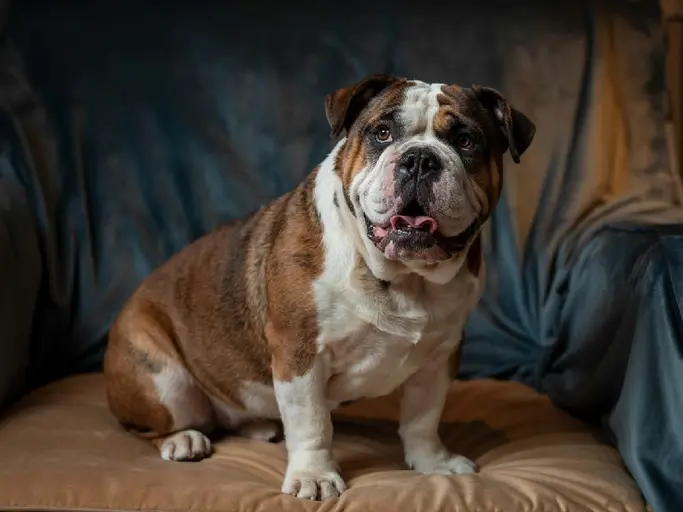The Bulldog: A Comprehensive Guide to This Lovable Breed

Brief Introduction
The Bulldog, also known as the British Bulldog, is a breed instantly recognizable for its distinctive, wrinkled face and stout build. They are known for their gentle and courageous nature, making them popular companions. Bulldogs have a unique charm that draws people in. Despite their somewhat intimidating appearance, they’re often described as docile, friendly, and even comical to be around.
Their physical attributes, such as their short muzzle and muscular body, contribute to their unique look, but these features also require specialized care and attention. They are often popular pets because of their affectionate nature and relatively low exercise needs, which makes them suitable for apartment living. But a potential owner needs to be aware of the health challenges faced by this breed.
Breed History
The Bulldog’s history is a far cry from the gentle giants we know today. Understanding their past helps contextualize their current temperament and breed-specific needs.
Origins and Early Purpose
The Bulldog’s origins can be traced back to 13th-century England. They were initially bred for bull-baiting, a cruel sport where dogs were pitted against bulls. This activity required dogs with immense courage, tenacity, and a high pain tolerance. The early Bulldogs were much larger and more aggressive than today’s breed.
Evolution and Transformation
Bull-baiting was outlawed in England in 1835. The Bulldog faced extinction, but enthusiasts saw the potential for a companion animal. Breeders selectively bred the Bulldog to reduce aggression and enhance their more endearing qualities. This led to the development of the modern Bulldog, a much gentler and more tractable dog.
The Modern Bulldog
The Kennel Club (England) recognized the Bulldog as a breed in 1886, and the American Kennel Club followed suit soon after. The modern Bulldog retains some of the physical characteristics of its ancestors, such as its muscular build and wide stance, but the temperament has been significantly altered through selective breeding. Today, they are primarily cherished as family pets.
Appearance
Size and Weight
Bulldogs are medium-sized dogs and they are a stout breed. The weight and size of the male and female are similar.
- Height: Typically 12-16 inches
- Weight: Typically 40-50 pounds
Coat and Color
The Bulldog has a short, smooth coat. Acceptable colors include:
- Brindle
- White
- Red
- Fawn
- Piebald (patches of color)
Colors can be combined, such as brindle and white, or red and white.
Head and Facial Features
The Bulldog’s head is one of its most defining features:
- Head: Large and broad
- Muzzle: Short and wide, with characteristic wrinkles
- Wrinkles: Prominent on the face and around the nose, requiring regular cleaning to prevent infection
- Nose: Broad and black
- Ears: Small, thin, and set high on the head. Rose ears (folding back slightly) are preferred.
- Eyes: Dark, round, and set wide apart
Body and Tail
The Bulldog’s build is low-slung and muscular. Other features include:
- Body: Stocky and powerful
- Chest: Broad and deep
- Legs: Short and sturdy
- Tail: Short, either straight or screw-shaped (forming a tight curl). A docked tail is undesirable.
Character and Behavior
While their appearance might suggest otherwise, Bulldogs are generally known for their good-natured and docile personalities. However, understanding their specific behavioral traits is key to responsible ownership.
Attitude Towards People
Bulldogs are often described as affectionate and loyal companions. They generally bond strongly with their families and crave attention. They are often good with children and are known to be patient, but as with any dog, supervision is essential, especially with very young children.
Interaction with Other Animals
Bulldogs can be good with other pets, especially if they are raised together. However, their strong prey drive (a remnant from their bull-baiting days) can sometimes surface, particularly with smaller animals like cats or rodents. Early socialization is crucial to ensure they get along well with other animals in the household.
Activity Level and Exercise Needs
Bulldogs have relatively low energy levels compared to many other breeds. They are prone to overheating, especially in hot or humid weather, so strenuous exercise should be avoided. Short walks, playtime, and mental enrichment activities are usually sufficient to keep them happy and healthy. Overexertion can be dangerous.
Trainability
Bulldogs can be somewhat stubborn and independent, which can make training a challenge. However, they are also intelligent and eager to please their owners. Positive reinforcement methods, such as treats and praise, are the most effective way to train them. Patience and consistency are key.
Breed-Specific Behavioral Traits
- Snoring: Bulldogs are known for their loud snoring due to their brachycephalic (short-nosed) structure.
- Drooling: They also tend to drool, particularly after eating or drinking.
- Stubbornness: Bulldogs can be stubborn and may try to get their way.

Care and Maintenance
Proper care is essential for keeping your Bulldog healthy and happy. Their unique physical characteristics require specific attention and tailored care routines.
Grooming
Bulldogs have short coats that require minimal grooming. Regular brushing (once or twice a week) will help to remove loose hair and keep their coat healthy. However, their wrinkles require daily cleaning to prevent infections. This is a critical part of their routine.
Exercise
Bulldogs need regular exercise to maintain a healthy weight and prevent obesity. Short, leisurely walks are usually adequate. Avoid strenuous exercise, especially in hot weather, as they are prone to overheating.
Feeding
Bulldogs are prone to weight gain, so it’s essential to feed them a high-quality dog food in the correct portion sizes. Consult with your veterinarian to determine the appropriate amount of food for your dog’s age, weight, and activity level.
Healthcare and Potential Health Problems
Bulldogs are prone to several health problems, largely due to their physical conformation. Regular veterinary checkups are essential for early detection and treatment. Common health issues include:
- Brachycephalic Obstructive Airway Syndrome (BOAS): This condition affects breathing due to the shortened muzzle and can require surgical correction.
- Hip and Elbow Dysplasia: These are conditions that affect the joints, leading to pain and lameness.
- Cherry Eye: Prolapse of the third eyelid gland, requiring surgical correction.
- Skin Infections: Wrinkles can trap moisture and debris, leading to infections.
- Heatstroke: Bulldogs are highly susceptible to heatstroke due to their breathing difficulties.
Proactive measures like weight control, wrinkle cleaning, and avoiding strenuous activity in hot weather can help mitigate these risks.
Breed Weaknesses
Potential for Aggression
While generally known for their gentle nature, some Bulldogs can exhibit aggression, particularly towards other dogs. This is often due to their historical breeding for bull-baiting. Early socialization and training can help to minimize this risk.
Loyalty
Bulldogs are exceptionally loyal to their families and can be protective. While this is a positive trait, it can also lead to possessiveness and guarding behaviors if not properly managed through training.
Specific Weaknesses
- High Veterinary Costs: Due to their predisposition to various health problems, Bulldog owners often face significant veterinary expenses.
- Sensitivity to Temperature: Bulldogs are highly sensitive to extreme temperatures, both hot and cold, and require careful management to prevent overheating or hypothermia.
- Breathing Problems: BOAS is a common and serious issue that can significantly impact a Bulldog’s quality of life.
Conclusion
The Bulldog is a unique and charming breed that can make a wonderful companion for the right owner. They are gentle, affectionate, and relatively low-energy, making them suitable for apartment living. However, potential owners must be prepared to address their specific care needs and potential health problems. Bulldogs require dedicated care, proactive management of their health, and consistent training to thrive. This beloved breed is best suited for owners who are prepared to invest time, money, and attention to ensure their Bulldog lives a happy and healthy life.
Frequently Asked Questions About Bulldogs
-
What is a Bulldog known for?
Bulldogs are known for their distinctive wrinkled face, stout build, and gentle yet courageous nature. They are also known for their loyalty ,affectionate behavior and relatively low exercise needs.
-
Are Bulldogs good family pets?
Yes, Bulldogs often make excellent family pets. They are generally good with children and bond strongly with their families. However, supervision is essential, especially with very young children.
-
How much exercise do Bulldogs need?
Bulldogs have relatively low energy levels and don’t require a lot of exercise. Short walks and playtime are usually sufficient. Avoid strenuous exercise, especially in hot weather, due to their susceptibility to overheating.
-
What are some common health problems in Bulldogs?
Common health issues in Bulldogs include Brachycephalic Obstructive Airway Syndrome (BOAS), hip and elbow dysplasia, cherry eye, skin infections, and heatstroke. Regular veterinary checkups are essential.
-
Do Bulldogs require special grooming?
While their short coats require minimal grooming, Bulldogs’ wrinkles need daily cleaning to prevent infections. Regular brushing (once or twice a week) will help to remove loose hair.
-
Are Bulldogs easy to train?
Bulldogs can be somewhat stubborn and independent, which can make training a challenge. However, they are also intelligent and eager to please their owners. Positive reinforcement methods, such as treats and praise, are the most effective way to train them.
-
Are Bulldogs prone to aggression?
While generally known for their gentle nature, some Bulldogs can exhibit aggression, particularly towards other dogs. Early socialization and training can help minimize this risk.
-
Do all Bulldogs snore a lot?
Yes, Bulldogs are known for their loud snoring due to their brachycephalic (short-nosed) structure.
-
Are Bulldogs sensitive to hot and cold temperatures?
Yes, Bulldogs are highly sensitive to extreme temperatures, both hot and cold, and require careful management to prevent overheating or hypothermia.
-
What should I feed a Bulldog?
Bulldogs are prone to weight gain, so it’s essential to feed them a high-quality dog food in the correct portion sizes. Consult with your veterinarian to determine the appropriate amount of food for your dog’s age, weight, and activity level.

